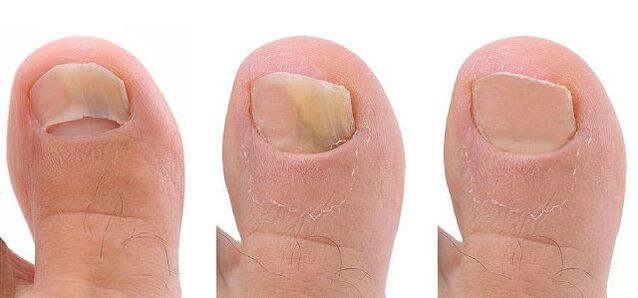The initial stages of toenail fungus or fingernail fungus may not manifest in any way until symptoms become apparent. Knowing the first signs of a disease flare is important here, because it's easier to overcome the fungus while the foot or toes are still weak than long-term treatment for the later stages. Timely detection of the disease is important because it has an incubation period.
what bacteria
The fungus on the feet or fingernails is called onychomycosis. It is caused by the following types of fungi:
- Dermatophytes;
- yeast;
- get mouldy.
They live mainly in the soil and from there spread to other surfaces that people can pass through. Toenail and hand nail fungus can enter the body through micro-cracks in the skin.
The incubation period lasts on average half a month, during which the fungus does not manifest in any way. As it penetrates into the skin and nourishes, the symptoms of the disease begin to appear. This manifests as an inflammatory process of the skin of the hands or feet. A person may experience an unpleasant odor in the affected finger area. If left untreated, the fungus can penetrate under the nail.
Signs of fungus on early nails

Before moving on to discussing the presentation of onychomycosis, you should know why the fungal disease started. The fungus on the legs and hands can spread from person to person, so the disease can easily be contracted in public places, such as saunas or swimming pools. The disease is spread by wearing ordinary shoes, which can occur in large households, or through the use of a towel or slippers.
The following conditions contribute to the development of foot fungus:
- Damaged nail plate.
- Excessive sweating of the hands or feet.
- flatfoot.
- The shoes are uncomfortable.
- Long-term antibiotic therapy.
- A weakened immune system.
- diabetes.
Fungal nail diseases manifest in different ways, depending on the type of pathogen. But there are also unifying signs when the disease is just beginning. What the fungus looks like, you can tell by the presence of the following symptoms:
- At the onset of onychomycosis, the structure and color of the nail plate changes.
- Nails become thicker and rougher.
- In some cases, cracks appear on the nail.
- Gradually, the nails started to chip from the inside and gave off an unpleasant smell.
- The latter acquires a matte appearance due to fungal activity between the skin and the nail plate.
- The color of the nails can be different - white, gray, yellow, green, brown.
In order not to bring the problem to this state, it is necessary to fight the infection at the beginning of the disease.
How to treat fungus in the initial stages

As mentioned earlier, the initial stages of nail fungus should be cured as early as possible. If you experience the above symptoms, you should see a doctor immediately. For a treatment to have the desired effect, the pathogen needs to be identified first.
Common therapeutic effects include:
- First, cut off the fungus-affected nail plate. This is best done by a doctor who will be able to clear the nail from the fungus without pain or discomfort.
- After that, cover the nail plate with an antifungal ointment or varnish. In the initial stages of the disease, you can't even take other treatments. But don't think once is enough -- you have to treat your nails every day, as your doctor prescribes.
- Antifungal pills are not usually prescribed in the initial stages of nail fungus, but if prescribed by a doctor, it is worth taking the pills. So the disease will pass quickly.
What are the modern methods for the initial treatment of nail fungus? The pharmaceutical industry offers a variety of medicines to treat foot fungus. These are sprays, ointments, drops, powders, varnishes. These funds are used not only for the treatment of onychomycosis but also for preventive purposes. They are able to penetrate deep under the skin and fight bacteria. But their effect is manifested only in mild forms of the disease or in the initial stages of fungal infections, but regular use of these drugs is required.
With advanced forms of onychomycosis, you fight the infection not only from the outside, but also from the inside.
In this case, the patient takes special pills to destroy the infection in the body. They should take it for a long time, several months, before seeing results.
Prevent fungal infections
It's not hard to get fungus on your legs and arms, but getting rid of it can be harder, so here's what you need to know about preventing the disease:
- Toenail fungus is not a threat to a person if he follows simple hygiene rules, changes socks more frequently, and wears shoes in public.
- Remember, you should always have personal hygiene items at hand - your own towels, towels and slippers.
- For cuts or other injuries to fingers and toes, treat the wound with antiseptic immediately.
If you follow these simple rules, you'll never know what the fungus is on your feet and hands. If an infection does occur, get rid of the disease at the initial stage, as problems will be minimal and it will be easier to eliminate them.















